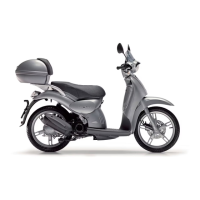
Do you have a question about the APRILIA SCARABEO 100 4T - 2007 and is the answer not in the manual?
| Year | 2007 |
|---|---|
| Manufacturer | Aprilia |
| Model | Scarabeo 100 4T |
| Category | Motorcycle |
| Cooling System | Air-cooled |
| Fuel System | Carburetor |
| Front Suspension | Telescopic Fork |
| Rear Suspension | Single shock absorber |
| Front Brake | Disc |
| Rear Brake | Drum |
| Front tire dimensions | 100/80-16 |
| Engine Type | Single Cylinder, 4-stroke |
| Max Torque | 7.5 Nm |
| Transmission | Automatic |
Read manual carefully before riding, especially safety and driving sections.
Manual is an important part of the vehicle and should always be kept with it.
Exhaust fumes contain toxic carbon monoxide; ensure adequate ventilation.
Gasoline is toxic and highly flammable; keep out of reach of children.
Engine and exhaust components get extremely hot; ensure they have cooled before touching.
Coolant contains flammable ethylene glycol; handle with care to avoid burns.
Used engine oil is carcinogenic if in prolonged skin contact; wash hands after handling.
Brake fluid is extremely toxic and irritating; avoid contact with skin and eyes.
Battery emits explosive gases; avoid flames and ensure ventilation during use or charging.
General precautions and advice for safe vehicle operation and maintenance.
Inform authorities and aprilia immediately about safety-affecting defects.
Know the rules of the road for the country where the vehicle will be used.
Warranty information for the exhaust system's compliance with noise emission standards.
Prohibition of tampering with the noise control system and related actions.
Symptoms indicating potential issues with motorscooter emissions and recommended actions.
Always carry out pre-ride checks before setting off to ensure correct and safe operation.
Instructions for safe refueling, including ventilation, no smoking, and avoiding spills.
Essential engine running-in procedures to preserve engine life and performance.
Procedures for starting the engine, including electrical and kick start methods.
Procedure for stopping the engine, including using brakes and avoiding sudden stops.
Instructions for parking the vehicle safely on firm, level ground.
Tips to prevent vehicle theft, including using locks and parking securely.
Comprehensive guide to safe driving practices, including vehicle use and rider conduct.
Importance of wearing appropriate protective clothing, helmet, gloves, and eyewear.
Guidelines for choosing, installing, and using vehicle accessories safely.
Instructions on how to load the vehicle safely without compromising stability or maneuverability.
Information on using the luggage rack and helmet compartment.
Importance of checking and maintaining correct engine oil level for lubrication and engine health.
Procedure for changing engine oil and cleaning the oil filter as per scheduled maintenance.
Procedure for checking the hub oil level, ensuring correct measurement.
Procedure for replacing transmission fluid as per scheduled maintenance recommendations.
Importance of checking tire pressure regularly and inspecting tire condition for safety.
Procedure for removing, cleaning, and inspecting the spark plug.
Procedure for removing the air filter for cleaning or replacement.
Safety precautions for handling the battery, including connections and hazards.
Procedure for checking battery electrolyte level and handling precautions.
Procedure for checking and cleaning battery leads and terminals for proper connection.
Step-by-step instructions for safely accessing and removing the vehicle battery.
Recommended procedure for recharging the vehicle battery using an appropriate charger.
Instructions for safely installing the vehicle battery, including breather connection.
Precautions for storing the vehicle for long periods to prevent damage due to inactivity.
Information on fuses, including replacement procedures and safety warnings.
Safety precautions and procedures for replacing vehicle bulbs.
Procedure for accessing and replacing bulbs in the front light assembly.
Information on rear lights; replacement requires changing the entire rear light group.
Procedure for replacing bulbs in the rear turn signals.
Procedure for adjusting or replacing rearview mirrors.
Procedure for adjusting the engine's idle speed according to the scheduled maintenance table.
Advice and procedures for checking and maintaining the front disc brake system.
Critical importance of maintaining disc brakes in perfect working order for rider safety.
Procedure for checking brake pad wear and determining when replacement is needed.
Importance of checking and maintaining the rear drum brake system for safety.
Precautions necessary when storing the vehicle for long periods to prevent damage due to inactivity.
Guidelines for cleaning the scooter, considering various conditions and substances.
Important precautions for safely transporting the vehicle, including fuel tank emptying.
Specifications for vehicle dimensions, weight, suspension, brakes, and wheels.
Technical specifications for the engine, including model, displacement, and bore/stroke.
Table listing all bulbs and warning lights with their specifications and types.
Description of the tools included in the vehicle's toolkit and their use.
Table outlining recommended maintenance tasks and their intervals based on mileage or time.
List of recommended lubricants, fluids, and parts for vehicle maintenance.
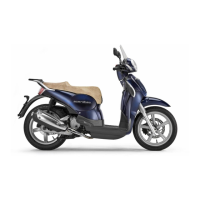


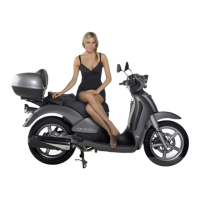
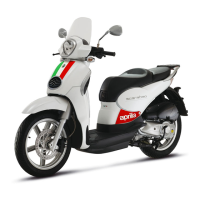
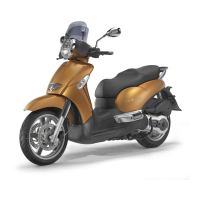

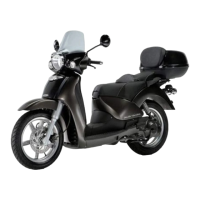
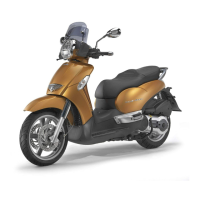



